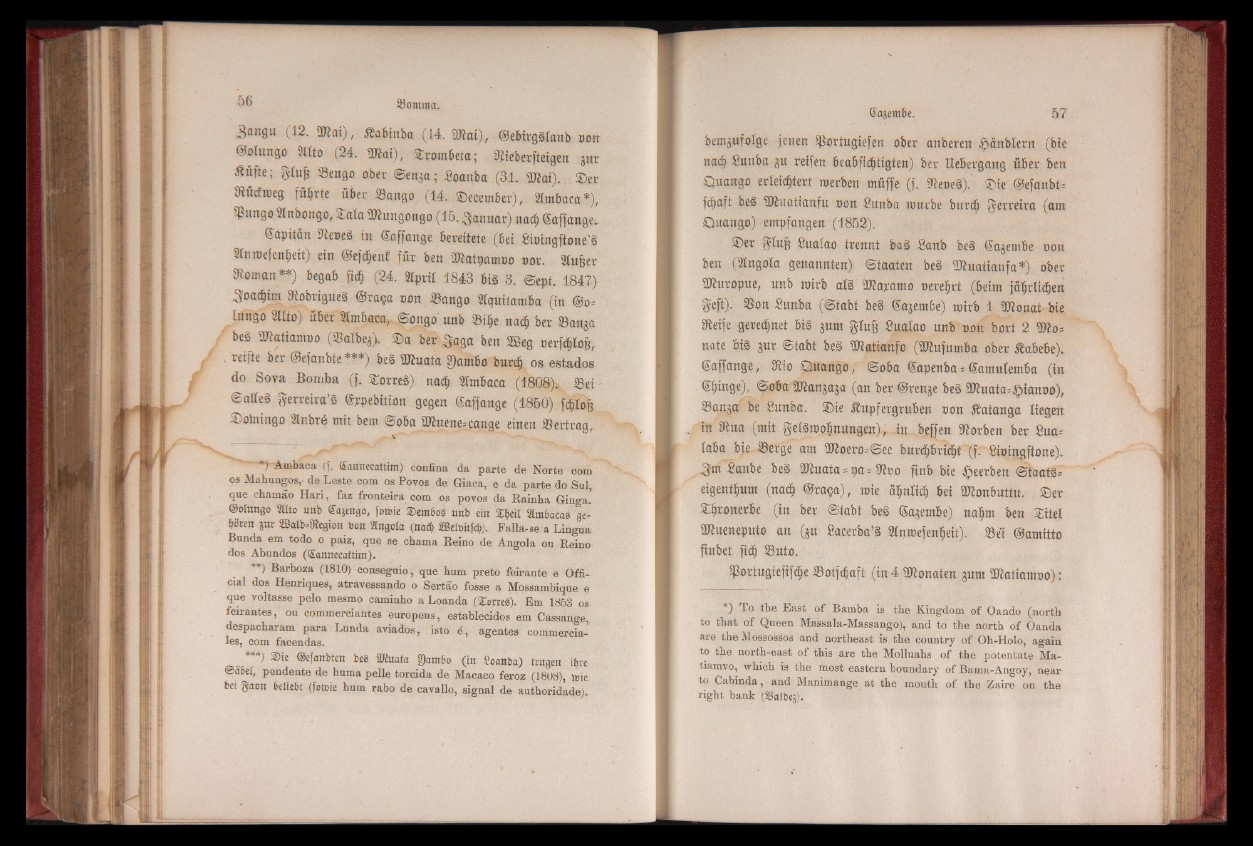
3angu (12. 5Dïai), .^abinba (14. ü)îfti)7 ©ebirgglanb doit
©olungo Ulto (24. a»oi)| îrombeta; lîieberfteigen m t
Äüfte; §lujj Sengo ober ©en^a; Soanba (31. 2M ), Qer
SftficftDeg führte über Sango (14. ©ecember), 2lmbaca*);
$ungo 2lnbongo, ©ala Siungongo (15. Januar) nadfj ©affange-
©apitän 97e»eg in ©affange bereitete (bei Sioingftone'g
2lni»efenheit) ein ©efôenf fur ben 2ttatpam»o »or. Slufeer
Vornan**) begab fic§ (24. Ülprii 1843 big 3. Sept. 1847)
3oadhim 9îobrigueg ©raça »on Sango STqUitamba (in ®o=
lungo 2llto) über Slmbaca, .©ongo unb Sihe nach ber Sanga
beg f c iam o o (Salbeg). ©a ber 3 aga ben 2Beg »erfd&lo&r
/reifte ber ©efanbte***) beg 2ftuata 2)ambo bur<| os estados
do Sova Bomba (f. ïorreg) nach limbaca (1808)., 53ei
©atteg fyerreira’g ©ppebition gegen ©affange (1850) fchlofr
©olningo Slnbré mit bem ©oba SDîuene=çange einen Sertrag,
- V ' ‘ ‘ ....
-*y Ambaca (|. Sannecattim) confina da parte de Norte com
os Mahungos,- de Leste com os Povos de Giaca, e da parte do Sul,
que chamâo Hari, faz fronteira com os povos da Rainha Ginga..
©olungo atito unb Sajengo, fotote SDemboS unb ein S^eil 3tm&aca8 ge-
büren sur 2Balb4Region bon Angola (nacf) 3Beiöitf$). Falla-se a Lingua
Bunda em todo o paiz, que se chama Reino de Angola ou Reino
dos Abundos (Sannecattim).
**) Barboza (1810) conseguio, que bum preto feirante e Official
dos Henriques, atravessando o Sertâo fosse a Mossambique e
que voltasse pelo mesmo caminho a Loanda (2orreS). Em 1853 os
feirantes, ou commerciantes europeus, establecidos em Cassange,
despacharam para Lunda aviados, isto é, agentes commerciales,
com facendas.
) ®ie ©efanbten be8 äJhiata 3)am6o (in Sounbci) trugen if)re
©ä&ei, pendente de huma pelle torcida de Macaco feroz (1808), mie.
bei gaon beliebt (fotcie hum rabo de cavallo, signal de authoridLde).
bemjufolge jenen ijlortugiefen ober anberen .fjänblern (bie
nach Sunba ju reifen beabfidjtigten) ber Uebergang über ben
Quango erleichtert roerben muffe (f. 97e»eg).' ©ie @efanbt=
fdjjaft beg Siuatianfu »on Sunba mürbe burclj f^erretra (am
Quango) empfangen (1852).
©er ^lujj Sualao trennt bag Sanb beg ©ajembe »on
ben (Angola genannten) ©taateri beg Siuatianfa*) ober
2J7uropue, unb roirb alg Siayamo »erehrt (beim jährlichen
$eft),' Son Sunba (©tabt beg ©ajembe) mirb 1 üftonat bie
Sfteife geredhnet big jum glujj Spalao unb »on bort 2 2)70=
nate big $ut ©tabt beg Utatianfo (Siufmnba ober Äabebe).
©affange, 9iio Quango, ©oba ©apenba = ©amulemba (in
©hinge), ©oba Dlangaja (an ber ©renje beg SJtuata^ianDo),
S anja be Sunba. ©ie Äupfergrubeit »on Katanga liegen
in Otua (mit gelgroohnungen)., in beffen 37orben ber Sua=
laba bie Serge am S7oero=©ee burdbbridht (f. Siningfione).
3 m Sanbe beg ÜÖiuata = pa = 97bo ftnb bie beerben @taatg=
eigenthum (nach ®ra§a), mie ähnlich bei Slon&uttu. ©er
Thronerbe (in ber ©tabt beg ©ajembe) nahm ben ©itel
2Jiueneputo an (gu Sacerba’g Slnroefenheit). Sei ©amitto
finbet fidh Suto.
Sßortugiefifche Sotfchaft (in 4 Senaten jum Dtatiam»o):
*) To the East of Bamba is the Kingdom of Oando (north
to that of Queen Massala-Massango), and to the north of Oanda
are the Mossossos and northeast is the country of Oh-Holo, again
to the north-east of this are the Molluahs of the potentate Ma-
tiamvo, which is the most eastern boundary of Bama-Angoy, near
to Cabinda, and Manimange at the mouth of the Zaire on the
right bank (Sßalbeg).